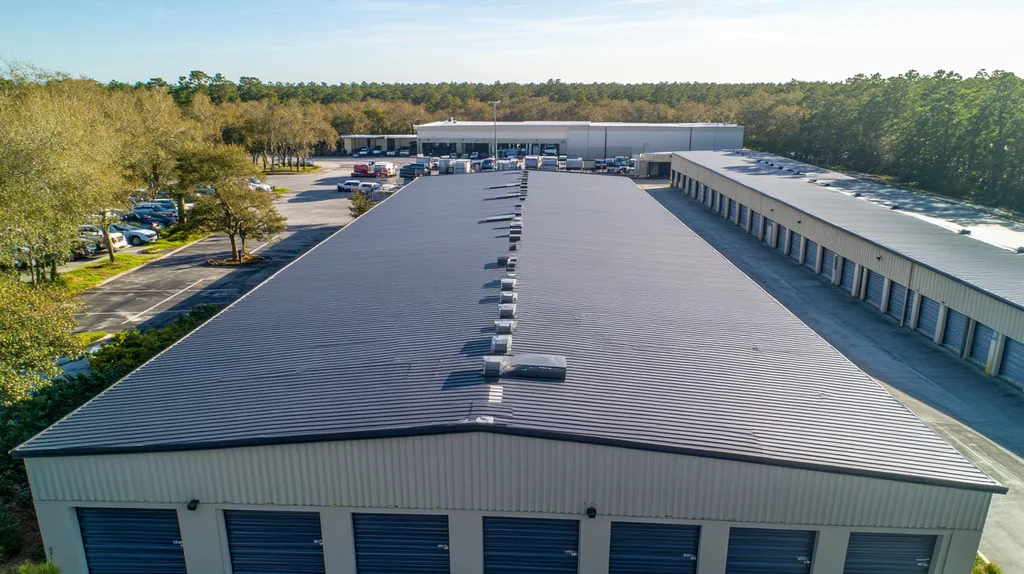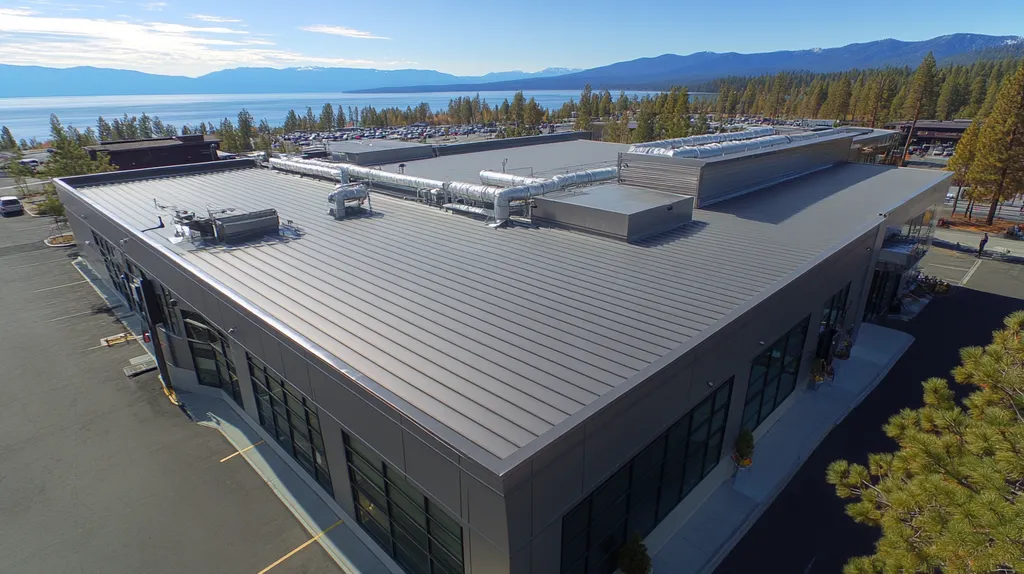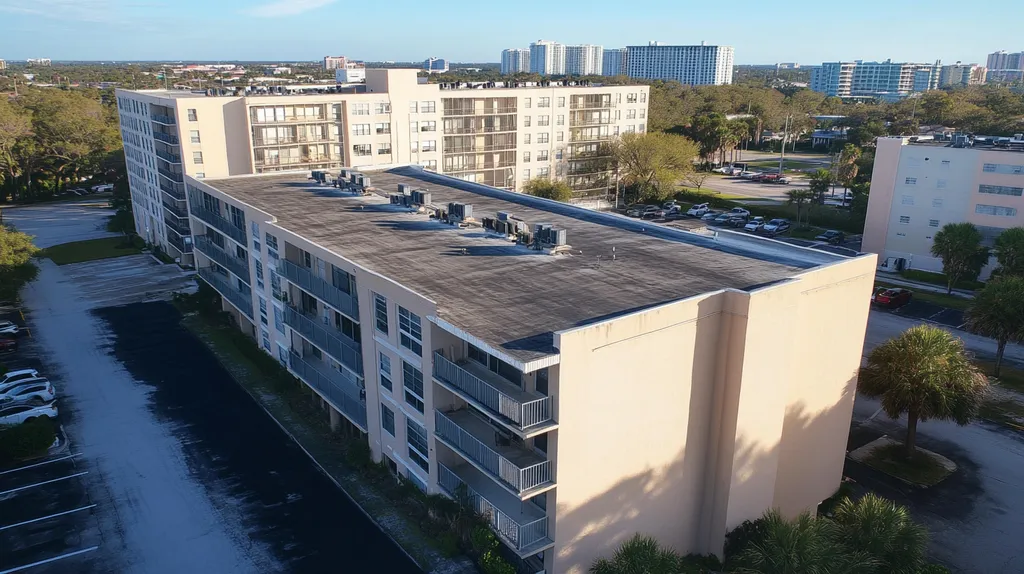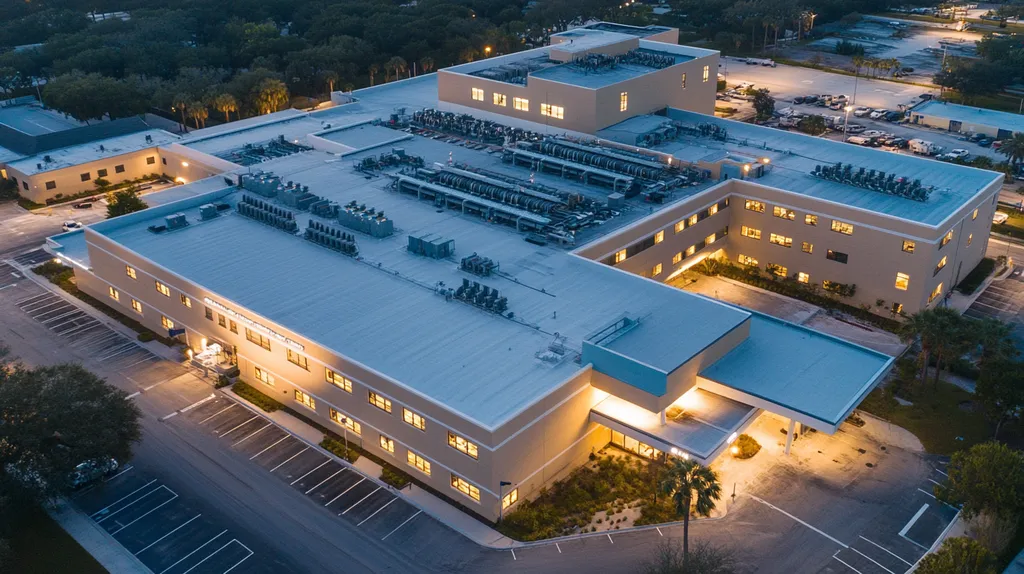In the evolving landscape of industrial roofing, weather-related application errors cost facility owners millions annually in premature coating failures and repairs. Industry data shows that up to 40% of roof coating projects face complications due to improper weather conditions during installation.
While advanced coating technologies have revolutionized industrial roofing since the days of traditional tar applications, the fundamental challenge of weather conditions remains a critical concern.
This comprehensive guide examines common misconceptions about weather conditions in coating applications, their practical implications, and evidence-based solutions that protect valuable roofing investments.
SECTION 1: COMMON MISCONCEPTIONS
In industrial roofing, understanding weather conditions is vital for successful coating applications. Misconceptions in this area can lead to financial setbacks and early roof failures. For example, improper timing driven by weather-related misunderstandings can inflate project costs by as much as 30%, while also risking damage from coatings applied under unsuitable conditions. It’s essential for property owners and facility managers to recognize these factors to avoid pitfalls.
Ignoring Humidity Levels
When planning roof coating applications, humidity is a critical factor that is often underestimated. It is a common misconception that dry weather alone guarantees a successful job. However, high humidity can severely impact the adhesion of coatings, causing significant issues.
When humidity levels rise above recommended thresholds, moisture can disrupt the bond between the coating and the roof’s surface. This may lead to bubbling, peeling, and a compromised roof structure. Proper humidity monitoring is essential for achieving effective coatings.
For instance, when humidity exceeds 85%, coatings may not cure as intended. Industry experts recommend an optimal humidity range of 40% to 60% for the best results, making this simple adjustment crucial for saving time and money.
A proactive strategy involves regularly checking local weather forecasts and using hygrometers to measure humidity levels on-site. By staying informed, property owners can avoid unnecessary downtime and extend the life of their roofs.
Overlooking Dew Point
The dew point is a key indicator that helps determine suitable conditions for applying coatings. Many property owners may not grasp the significance of this metric, leading them to proceed with projects during unfavorable conditions. When the surface temperature approaches the dew point, condensation can form, severely undermining the coating’s effectiveness.
If dew point levels are disregarded, the consequences can be dire. Coatings applied too close to the dew point may not adhere correctly, allowing moisture to become trapped beneath the material.
To ensure optimal performance, professionals should apply coatings when the surface temperature is at least 5°F higher than the dew point. Following this guideline can prevent costly failures and secure necessary protection for industrial roofs.
Utilizing local weather data and a dew point calculator can help avoid this common mistake. Ignoring dew point conditions can drastically shorten the lifespan of an industrial roof.
Misjudging Temperature Requirements
Temperature is another critical factor that should not be underestimated in the coating application process. Property owners often think that any warm, dry day is suitable for coatings, a misunderstanding that can lead to costly mistakes.
Coatings typically require specific temperature ranges for successful application. Coatings may fail to cure properly if the surface is too cold, while excessive temperatures can lead to rapid curing, causing cracks and other failures.
For example, many coatings need surface temperatures to be at least 50°F but not exceed 90°F for optimal performance. Overlooking these guidelines can result in premature issues that require expensive repairs.
To navigate these challenges, it’s crucial to consult product data sheets for temperature specifications. By understanding these requirements, roofing projects can be executed smoothly, avoiding unintended setbacks.
SECTION 2: PRACTICAL IMPLICATIONS
Weather conditions are not just background noise; they are a crucial element in the successful application of industrial roof coatings. Extreme temperature swings and high humidity can jeopardize the adhesion of coatings, leading to costly repairs and diminished roof lifespan. It is vital for property owners and facility managers to grasp these weather-related risks to avoid significant financial liabilities down the road.
Impact on Coating Adhesion
Coating adhesion is the backbone of effective industrial roofing. If temperatures are too low, the essential chemical bond may fail, resulting in peeling and flaking. For instance, coatings typically need temperatures over 50°F for proper adhesion; applying them in colder weather can trap moisture beneath the surface, exacerbating adhesion problems later.
High humidity levels also complicate the curing process, potentially weakening adhesion quality. Strong winds or unexpected rain can wash away wet coatings before they have a chance to set, leading to unsightly and uneven surfaces.
Understanding and monitoring appropriate weather conditions can significantly improve adhesion. This, in turn, safeguards the integrity of a roof system, protecting the investment property owners have made.
Effects on Drying Time and Curing
Drying time is a pivotal factor for roof coatings. Elevated humidity levels can severely hamper evaporation, fundamental to proper curing. In conditions where humidity exceeds 85%, drying times may balloon by 50% or more, delaying when a roof can be put back into service.
This extended drying period can create logistical challenges, forcing facility managers to adjust schedules to minimize interruptions. Without adequate curing, the coating will not achieve its intended thickness or durability, potentially leaving the roof defenseless against future wear and tear.
Understanding how weather impacts drying times is essential for planning effective maintenance schedules. Taking these elements into account can lead to lower roofing costs and reduced risk over time.
Risk of Premature Coating Failure
Premature coating failure is a substantial economic setback for property owners. Coatings applied under adverse weather conditions can experience a range of failures, such as bubbling, wrinkling, or even complete delamination. Studies show that roofing systems coated during rainy seasons have up to a 30% higher failure rate.
When coatings fail to adhere or cure correctly, their usable life dramatically shortens, resulting in the costly burden of early replacement for property owners. This financial strain affects budgets and can disrupt normal business operations.
Additionally, visible coating failures can tarnish the aesthetic appeal of a facility, impacting the impressions formed by clients and stakeholders. Thus, being aware of the risks associated with weather conditions is essential for informed decision-making.
In summary, timing roof coating applications to avoid adverse weather conditions is key to preventing premature failures, ensuring the longevity of investments, and maintaining operational integrity.
SECTION 3: COST OF MISINFORMATION
The improper application of roof coatings due to misleading weather information can unleash significant financial consequences. Coatings that fail prematurely often require costly replacements, placing undue strain on operational budgets. Industry surveys indicate that facilities incur an average of 25% higher expenses for roofs that fall short of performance expectations because of poor weather-related decisions. Addressing these misconceptions is essential for sustaining durable roofing systems, which in turn fosters longer-lasting investments and substantial savings.
Financial Consequences of Failed Coatings
Neglecting adverse weather conditions can place a facility’s financial foundation at serious risk. When coatings are applied in unsuitable settings, they may peel, crack, or bubble. Such failures demand immediate repairs or replacements, often costing 30% to 50% more than standard maintenance.
For example, applying roof coatings in high humidity can reduce a roof’s lifespan dramatically—from an anticipated decade to barely three functional years. The initial cost-saving from not adhering to proper application guidelines can spiral into significant long-term expenses.
Moreover, complications arise with warranty claims when coatings fail due to improper application. Manufacturers often stipulate specific environmental conditions for warranty coverage, which could leave property owners facing out-of-pocket costs if claims are denied.
Investing strategically in proper application not only protects initial expenditures but is essential for ensuring that roofing investments yield maximum longevity.
Increased Maintenance and Repair Costs
Premature coating failures can trigger spiraling maintenance and repair expenses. Facilities may find themselves diverting funds to address unforeseen repairs, affecting budgets meant for other critical projects. Research shows that facilities with improperly applied coatings can experience maintenance costs up to 40% higher due to persistent leaks and consequent structural damage.
Delaying repairs only exacerbates the situation; moisture infiltration can lead to mold growth and further deterioration of the building’s structure. Addressing such issues promptly can save property owners significant amounts in future expenses.
A proactive approach to verifying weather conditions prior to application can minimize unnecessary costs and keep financial plans stable. Facilities with correctly applied coatings typically require less maintenance, enhancing overall budget efficiency.
Recognizing the financial implications of increased repair needs highlights the crucial nature of a disciplined approach when navigating roofing applications amidst unpredictable weather.
Energy Efficiency and Performance Losses
Improperly applied coatings do more than cause physical damage; they also jeopardize energy efficiency. Roofs that cannot maintain their integrity may suffer from thermal inefficiencies, with heating and cooling costs soaring 15% to 25% higher in facilities with compromised roofs.
Additionally, diminished reflective properties from damaged coatings lead to increased energy consumption, resulting in inflated utility bills that eat into a company’s bottom line. In extreme cases, operational costs may even double over time due to ongoing energy inefficiencies.
The long-term performance losses not only affect direct energy costs but also undermine overall operational productivity. Meeting energy efficiency goals becomes more challenging when roofing systems fail to perform, potentially affecting building certifications and government incentives.
To avoid these significant repercussions, property owners must prioritize careful weather assessments and ensure proper application of roofing materials, thus safeguarding their investments while bolstering overall efficiency.
SECTION 4: REALITY CHECK
For industrial roofing professionals, the implications of applying coatings under unsuitable weather conditions cannot be overstated. Neglecting these factors can result in significant financial setbacks and premature roof failures. For instance, applying coatings in high humidity can reduce adhesion by over 50%, leading to costly repairs down the line. This section explores essential elements: recognizing climate variations, the critical need for real-time weather monitoring, and understanding substrate conditions to ensure optimal coating compatibility.
Understanding Climate and Weather Variations
Climate is a decisive factor in determining the right timing for roof coating applications. In hot regions, for instance, materials may cure too swiftly, diminishing their effectiveness. Conversely, colder climates can slow the application process significantly, requiring professionals to adapt their strategies accordingly.
Moreover, seasonal weather patterns—like heavy rain or snow—can render roofing surfaces too damp for effective adhesion. This common oversite could drastically impact both the performance and longevity of the roof.
Furthermore, every coating material has distinct characteristics that respond differently to varying climate conditions. For example, some elastomeric coatings thrive in warmer temperatures, while others necessitate cooler environments to cure effectively. Recognizing these distinctions equips roofing professionals to make well-informed decisions throughout the project.
Ultimately, an understanding of local climate variations is pivotal for timely and effective roof maintenance. Adapting application strategies based on localized weather can lead to more successful outcomes.
Importance of Real-Time Weather Monitoring
In the modern world of industrial roofing, real-time weather monitoring is vital for successful projects. By employing advanced weather tracking technologies, professionals gain immediate insights into conditions that might disrupt coating applications. Regularly monitoring humidity levels and wind speeds enables better decision-making regarding project schedules.
Many roofing failures stem from a lack of awareness about real-time weather fluctuations. Coating applications made without current data are susceptible to risks, often requiring costly rework due to adhesion issues. Continuous monitoring helps mitigate these risks.
Moreover, technology can indicate when it’s safe to apply coatings, removing much of the uncertainty from the equation. With real-time access to weather forecasts, crews can be scheduled to work only under favorable conditions, which enhances both project timelines and budget management.
In essence, integrating real-time weather monitoring tools into roofing operations significantly boosts the chances of successful coating applications.
Substrate Conditions and Coating Compatibility
A comprehensive understanding of substrate conditions is crucial for effective coating applications. Each type of roof substrate—be it metal, modified bitumen, or single-ply—interacts differently with various coat materials. An inadequate choice can result in challenges such as UV damage or moisture infiltration, jeopardizing the entire roofing system.
Additionally, the cleanliness of the surface is essential for compatibility. Contaminants can prevent proper adhesion if substrates aren’t adequately cleaned—a critical detail that is often overlooked but can lead to major failures.
Temperature also influences substrate conditions, affecting how coating materials behave. For instance, if a metal roof is too hot, it may cause applied coatings to cure too quickly, which can result in cracking and peeling. Acknowledging these specifics is fundamental for appropriate application.
Overall, ensuring the correct combination of substrate conditions and coating compatibility is key to maximizing the performance and lifespan of industrial roofing systems.
SECTION 5: EVIDENCE-BASED ALTERNATIVES
When weather conditions disrupt industrial roof coating applications, the consequences can be significant. Delays can inflate costs and prolong facility downtime, punching holes in budgets and schedules. Data indicates that improper timing can severely shorten coating lifespans, costing companies thousands in rectify work. To address these challenges, property owners and facility managers must explore evidence-based alternatives tailored to their specific climate conditions. This section investigates climate-specific coatings, flexible application windows, and technology use for monitoring weather conditions.
Selecting Climate-Specific Coatings
Choosing coatings that fit specific climatic conditions can dramatically enhance their performance. For instance, highly reflective coatings are perfect for hot climates, reducing heat absorption and lowering cooling costs. On the other hand, elastomeric coatings shine in regions with temperature fluctuations, flexing without cracking to accommodate expansion and contraction.
Coatings aren’t one-size-fits-all; different materials react in unique ways to various weather conditions. Some polyurethanes may cure too rapidly in humid environments, while others thrive in the same conditions. Understanding local climates allows property managers to select the appropriate coatings, minimizing the risk of application failures.
Innovative options like silicone coatings provide superior resistance against ponding water and UV degradation, making them suitable for regions with heavy rainfall or tropical climates. Aligning coating choices with environmental conditions not only promotes durability but also compliance with industry standards.
Investing time in understanding climate-specific solutions saves money by lowering maintenance needs and preventing premature replacements—ultimately protecting valuable assets and ensuring long-term reliability.
Adjusting Application Windows for Weather
Shifting the application schedule in tandem with weather forecasts can greatly boost coating efficacy. Precise weather predictions help roofing professionals pinpoint ideal application windows, thus averting complications such as unexpected rain or sudden temperature drops. This strategy allows facilities to minimize moisture exposure and guarantees adequate curing time for coatings.
For instance, scheduling applications when temperatures remain consistently above 50°F and the likelihood of precipitation is low enhances adhesion and longevity. Even minor adjustments can significantly improve overall roof performance and reduce the frequency of future reapplications.
Moreover, proactively extending application windows around seasonal weather patterns enables a safer and more effective working environment. This flexibility allows roofing teams to adapt to fluctuations in weather without significantly disrupting project timelines.
By being both proactive and flexible, facility managers can ensure optimal roof performance, ultimately lowering costs and extending the lifespan of their roofing investments.
Using Weather Apps for On-Site Monitoring
Incorporating weather monitoring applications provides crucial real-time information that facilitates informed decision-making during coating applications. These tools deliver updates on important factors, such as temperature, humidity, and precipitation forecasts, equipping facility managers with actionable insights for successful projects.
Contractor-specific weather apps can track localized patterns and alert teams when conditions become favorable or unfavorable. This level of detail allows for swift responses and adjustments to plans, effectively reducing disruptions to workflow.
Moreover, detailed weather analytics support future predictions, enhancing overall planning efforts. By keeping all stakeholders informed, coordination between roofing crews and facility management improves markedly.
With the right technological tools in hand, roof coating projects can be executed with precision, leading to healthier roofs and lower repair costs over time.
SECTION 6: TEST AND VERIFY
The success of an industrial roof coating application hinges on meticulous testing and verification. Inappropriate weather conditions can not only lead to failed applications but also pose safety risks. Alarmingly, industry reports indicate that nearly 30% of roof coatings fail due to improper application associated with unmonitored weather factors. To combat these issues, a systematic approach to pre-application testing, real-time monitoring during the application, and thorough post-application inspections is essential. Each step is a safeguard for investments and structural integrity.
Conducting Pre-Application Tests
Before applying any coating, conducting pre-application tests is vital to ensure optimal surface conditions. These tests evaluate moisture levels, surface temperature, and the presence of contaminants like oil or dirt. For instance, any moisture level exceeding 16% can significantly impact adhesion and overall performance. A simple surface tension test can also indicate whether additional cleaning is required.
Using a hygrometer to gauge humidity levels confirms whether conditions are suitable for coating application. If tests reveal that conditions aren’t optimal, it’s essential to delay the job until the criteria are met. This investment in time can yield significant long-term benefits by minimizing future issues.
Employing a temperature sensor is also crucial, ensuring that substrate temperatures remain within recommended ranges throughout the project. These tests yield critical data, enabling informed decisions and avoiding costly mistakes. Skipping this foundational step often leads to premature failures of roof systems.
Awareness of local weather patterns is paramount in this process. By planning ahead, property owners can align projects with favorable conditions, saving both time and resources while enhancing overall project efficiency.
Monitoring Weather Conditions During Application
Real-time weather monitoring during the application process is as essential as pre-application tests. Conditions can change swiftly, impacting the integrity of the coating. A sudden downpour or drop in temperature can ruin an otherwise successful application.
Utilizing weather apps or onsite meteorological equipment allows crews to track shifting conditions. High humidity can affect curing times, leading to inadequate performance if not addressed promptly. Property managers should have contingency measures ready to tackle such fluctuations effectively.
It’s also crucial to keep the application crew informed about weather-related protocols. Knowing when to pause and resume work ensures both quality and safety. Strong communication reduces risks tied to unexpected weather changes.
Moreover, leveraging advanced weather forecasting services adds an extra layer of assurance. Accurate forecasts empower facility managers to optimize application schedules, enhancing the likelihood of achieving durable roofing solutions.
Post-Application Inspection and Verification
After the coating application, conducting a thorough post-application inspection is essential. This phase is critical for identifying potential adhesion problems or surface defects that could lead to failure. Prompt inspections enable immediate corrections when issues arise.
Inspectors should focus on uniform coating thickness and check for bubbling or peeling. A meticulous examination ensures that any problems are rectified before they escalate, while also verifying that the coating meets industry standards.
Documenting inspection findings serves as an invaluable reference for future maintenance. Maintaining detailed records can assist in warranty claims and support long-term asset management strategies, ultimately prolonging the lifespan of the roofing system.
Additionally, conducting a follow-up meeting with the application team can yield valuable insights. Collaborative discussions promote continuous improvement and identify challenges encountered during the process. This evaluative approach solidifies the groundwork for future projects, making ongoing success more attainable.
Looking Ahead
As industrial roofing evolves beyond the tar-and-gravel systems of decades past, weather conditions remain the decisive factor between success and failure in coating applications.
Industry data reveals that weather-related coating failures cost facility owners an estimated $400 million annually in premature replacements and repairs.
The evidence is clear: proper weather monitoring, climate-specific material selection, and rigorous testing protocols are not optional considerations but essential requirements for modern industrial roofing.
With 40% of coating failures linked directly to improper weather conditions during application, facility managers must embrace technology-driven monitoring and evidence-based application windows.
The future of industrial roof coating lies in combining traditional expertise with advanced weather analytics, ensuring investments are protected for decades to come.
FREQUENTLY ASKED QUESTIONS
Q. What are common misconceptions about commercial roof coatings and weather?
A. Many believe that dry weather alone guarantees successful applications. In reality, humidity and dew point can significantly impact adhesion, leading to premature failures. Recognizing these misconceptions is crucial for effective roofing to avoid costly mistakes.
Q. How do weather conditions affect adhesion in industrial roof coatings?
A. Temperature and humidity play pivotal roles in coating adhesion. Coatings need specific temperatures; too cold or hot can lead to failure. High humidity can also hinder curing, complicating the adherence of materials and risking costly repairs.
Q. What financial consequences arise from failed commercial roof coatings?
A. Neglecting proper weather conditions can lead to peeling and bubbling of coatings, resulting in expensive repairs. Additionally, warranties might not cover failures that occur without adhering to proper application guidelines, demanding further financial outlay.
Q. Why is real-time weather monitoring important for industrial roofing?
A. Real-time monitoring helps track changing weather conditions that can affect coating applications. Knowing the current humidity and temperature allows roofing professionals to make informed decisions, ultimately avoiding costly mistakes and ensuring successful projects.
Q. What are the effects of applying coatings at the wrong temperatures?
A. Coatings applied in inappropriate temperature ranges may fail to cure correctly, resulting in issues such as cracking or peeling. This can lead to a shorter lifespan for the roof and unnecessary repair costs, impacting financial planning.
Q. How can technology help with roofing applications amidst uncertain weather?
A. Utilizing weather tracking apps can provide crucial insights into current and forecasted conditions. These tools help facility managers and roofing professionals make timely decisions, leading to better outcomes and minimized disruptions during application processes.
Q. What kinds of coatings are suitable for specific climates?
A. Climate-specific coatings exist to optimize performance. Reflective coatings work well in hot areas to reduce heat, while elastomeric coatings can flex in regions with temperature swings, ensuring longevity and efficiency for commercial roofs.










